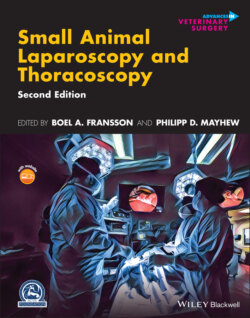Читать книгу Small Animal Laparoscopy and Thoracoscopy - Группа авторов - Страница 138
Development of a New Platform
ОглавлениеThe early history of single‐port style laparoscopic surgery may date back to its early use in laparoscopic gynecologic surgery when Wheeless and Thompson described more than 1000 tubal ligations using a single puncture laparoscope with an offset eye piece [9]. However, purists within the contemporary single‐port arena argue that operative laparoscopy differs significantly from modern‐day single‐port surgery, and the origins of the single‐port surgical revolution were developed more recently. The first use of separate instruments and ports through a single incision was initially described in 1997 by Navarra et al., when they published their “one wound cholecystectomy” using two transumbilical trocars [10]. At that time, single‐port surgery seemed as if it was not ready to emerge as a viable access platform for the mainstream and even Navarra himself questioned the validity of that approach in terms of its safety, efficacy, and operative time. It was not until 2007, when Curcillo revisited Navarra's work and described a stepwise approach for the reduction of port sites and consolidation of trocars, resulting in one umbilical incision for laparoscopic cholecystectomy named single‐port access (SPA) [11]. Since 2007, a massive emergence of single‐port procedures has been successfully adapted to many common multiport laparoscopic abdominal procedures in both children and adults with the ultimate goal of reducing overall surgical invasiveness. The single‐port platform evolved rapidly with the objectives of minimizing overall surgical trauma, reducing postoperative pain, shortening convalescence, and improving cosmesis [11]. In humans, it is speculated that the potential advantages that single‐port surgery has over conventional multiport laparoscopy include superior cosmesis from a relatively hidden umbilical scar; a possible decrease in morbidity related to visceral and vascular injury during trocar placement; and risk reduction of postoperative wound infection, hernia formation, and elimination of multiple trocar site closures [12]. To date, there have been several systematic reviews and metanalyses describing the comparison of conventional laparoscopic and single‐port procedures, as well as a handful of prospective, randomized controlled trials [8,13–19]. Although a broad generalization cannot be made; there is a general trend toward shorter hospitalization stays, less need for postoperative analgesia, and lower pain scores associated with single‐port surgery when compared to conventional laparoscopy.
It should also be noted that within the human literature, including both clinical case series and laboratory‐based skill acquisition studies, evidence has demonstrated unique requirements of single‐port surgery. Skill sets and ergonomic demands cannot be directly adapted from existing laparoscopic experience, and the implementation of an evidence‐ and competency‐based single‐port training curriculum is necessary to ensure appropriate training of future single‐port surgeons [19]. An evaluation of the learning curve for the single‐port ovariectomy for a board‐certified veterinary surgeon has also been reported [20]. The study described that the learning curve for single‐port ovariectomy was short (optimal performance after approximately eight procedures), and proficiency can be achieved within a definable period.
